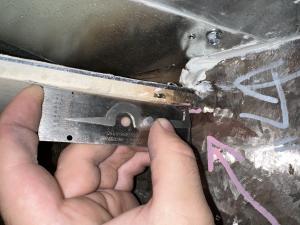Essential Tips for Effective Welding Inspection Racine Services
Wiki Article
Ingenious Strategies to Fillet Weld Examination and Testing: Enhancing Weld High Quality and Conformity Specifications
In the world of welding, the high quality and integrity of fillet welds play an important role in making certain the architectural sturdiness and dependability of different commercial parts. With the constant drive for boosted effectiveness and compliance with stringent standards, the expedition of cutting-edge techniques to fillet weld inspection and testing has actually come to be crucial.Advanced Non-Destructive Screening Techniques
Using cutting edge technologies, advanced non-destructive testing techniques play a critical function in making certain the integrity and top quality of fillet welds. These techniques, such as phased selection ultrasonic screening (PAUT) and magnetic particle testing (MPT), deal comprehensive understandings into the weld's internal structure without triggering any type of damage to the product. PAUT, for circumstances, utilizes numerous ultrasonic components to evaluate the weld from various angles, giving a detailed visualization of potential flaws like lack of fusion or fractures.Similarly, MPT is efficient in identifying surface-breaking problems by using a magnetic field and iron particles to the weld location. This technique is specifically useful for recognizing gaps that might jeopardize the weld's toughness. By using these advanced non-destructive screening techniques, weld inspectors can properly examine the top quality of fillet welds, making sure compliance with sector requirements and policies. The capability to discover imperfections at an early stage not just enhances weld quality yet additionally avoids costly rework or failings in structural integrity, highlighting the relevance of these innovative testing approaches in welding assessments.
Robotics and Automation in Inspection
The combination of robotics and automation has reinvented the inspection procedure for fillet welds, enhancing performance and precision in top quality analysis. Robotics supply accurate control and repeatability in checking welds, making certain regular and dependable results. Automated systems can be configured to comply with specific assessment paths, guaranteeing complete insurance coverage of welds and reducing the threat of human error.Robot examination systems equipped with innovative sensing units can spot and determine weld features with high precision, providing thorough information for analysis. These systems can identify issues such as splits, absence of blend, and porosity, allowing prompt corrective actions to be taken. Furthermore, robotics and automation allow for real-time data collection and analysis, offering prompt responses to operators and facilitating fast decision-making processes.
In addition, the usage of robotics and automation in fillet weld inspection boosts total productivity by reducing examination times and raising assessment throughput. By enhancing the assessment process, producers can ensure weld top quality and compliance standards are satisfied successfully, inevitably causing cost financial savings and boosted item quality.
Making Use Of Expert System for Evaluation
Man-made intelligence plays a critical function in improving the performance and accuracy of evaluation in fillet weld examination processes. By using the power of AI, inspectors can improve the evaluation of weld top quality and conformity criteria, resulting in much more dependable and accurate results. AI algorithms can quickly refine huge quantities of information from weld assessments, spotting flaws or incongruities that may be testing to relate to the naked eye. This sophisticated innovation enables real-time surveillance of weld high quality, permitting for instant corrective activities to be taken if any type of concerns are detected.Furthermore, AI systems can pick up from past examination information, continuously improving their capacity to recognize potential problems and deviations in fillet welds. This adaptive discovering capacity improves the total quality assurance process, reducing the possibility of human error and making sure that welds meet the called for requirements. By incorporating expert system right into fillet weld analysis, industries can achieve higher degrees of effectiveness, consistency, and compliance in their inspection methods.
Portable Equipment for On-Site Inspection
 Enhancing field inspection performance, the fostering of mobile devices transforms on-site assessment processes for fillet welds. These tools supply versatility and benefit, allowing assessors to conduct thorough assessments in different locations, including tough or remote environments. Portable tools such as ultrasonic testing devices, magnetic bit inspection devices, and digital radiography systems helpful resources supply real-time data and high-resolution imaging capabilities, making it possible for fast decision-making and prompt comments on weld top quality.
Enhancing field inspection performance, the fostering of mobile devices transforms on-site assessment processes for fillet welds. These tools supply versatility and benefit, allowing assessors to conduct thorough assessments in different locations, including tough or remote environments. Portable tools such as ultrasonic testing devices, magnetic bit inspection devices, and digital radiography systems helpful resources supply real-time data and high-resolution imaging capabilities, making it possible for fast decision-making and prompt comments on weld top quality.One considerable advantage of mobile devices is their capability to improve inspection procedures, decreasing downtime and enhancing total productivity. Assessors can easily move these devices to different work websites, eliminating the need for transporting heavy equipment or parts to off-site centers. Additionally, the portability of these devices advertises cost-effectiveness by decreasing transportation expenses and increasing assessment timelines.
Furthermore, the use of mobile devices for on-site assessment advertises positive high quality control steps, as inspectors can promptly recognize and deal with any kind of prospective welding defects or inconsistencies. By integrating these cutting-edge innovations into on-site examination practices, welding professionals can guarantee conformity with industry requirements and enhance weld quality, eventually resulting in improved structural stability and security in various welding applications.
Assimilation of Data Monitoring Solution
Having actually maximized on-site evaluation procedures through the usage of mobile tools, the next go to website phase includes the smooth assimilation of data administration systems to better enhance efficiency and data evaluation capacities in fillet weld examination and testing. Welding Inspection Racine. By incorporating information management systems into the evaluation process, companies can simplify information collection, storage, and analysis. This combination enables real-time surveillance of weld top quality, instant recognition of defects, and timely decision-making to remedy any type of problems that may occur during the assessment process
Data administration systems play a vital role in systematizing examination information, helping with simple gain access to for licensed personnel, and guaranteeing data honesty and protection. With the integration of these systems, examiners can generate detailed reports, track historic data for fad analysis, and improve total process effectiveness. The integration of data administration systems enables smooth interaction between various stakeholders involved in the assessment process, cultivating collaboration and improving total quality control steps. Eventually, the assimilation of data management systems serves to elevate the criteria of fillet weld inspection and screening, making certain compliance with industry policies and improving weld high quality.
Final Thought
To conclude, cutting-edge methods to fillet weld examination and screening have dramatically boosted weld quality and conformity criteria. Advanced non-destructive testing methods, robotics, automation, expert system, mobile tools, and information management systems have actually reinvented the way weld assessments are conducted. By using these innovations, industries can make sure that welds satisfy the required quality standards and laws, ultimately boosting total performance and safety in welding procedures.
By using these innovative non-destructive testing methods, weld assessors can accurately examine the quality of fillet welds, ensuring compliance with market standards and laws. Portable devices such as ultrasonic screening gadgets, magnetic bit inspection equipment, and digital radiography systems supply real-time data and high-resolution imaging site web abilities, making it possible for fast decision-making and prompt feedback on weld quality.
Having enhanced on-site assessment processes via the use of portable devices, the next stage entails the seamless integration of data management systems to further boost effectiveness and data analysis capabilities in fillet weld assessment and testing (Welding Inspection Racine). Eventually, the assimilation of information administration systems serves to boost the standards of fillet weld examination and screening, making sure compliance with industry policies and boosting weld top quality
 In verdict, innovative techniques to fillet weld assessment and testing have considerably boosted weld quality and compliance criteria.
In verdict, innovative techniques to fillet weld assessment and testing have considerably boosted weld quality and compliance criteria.Report this wiki page